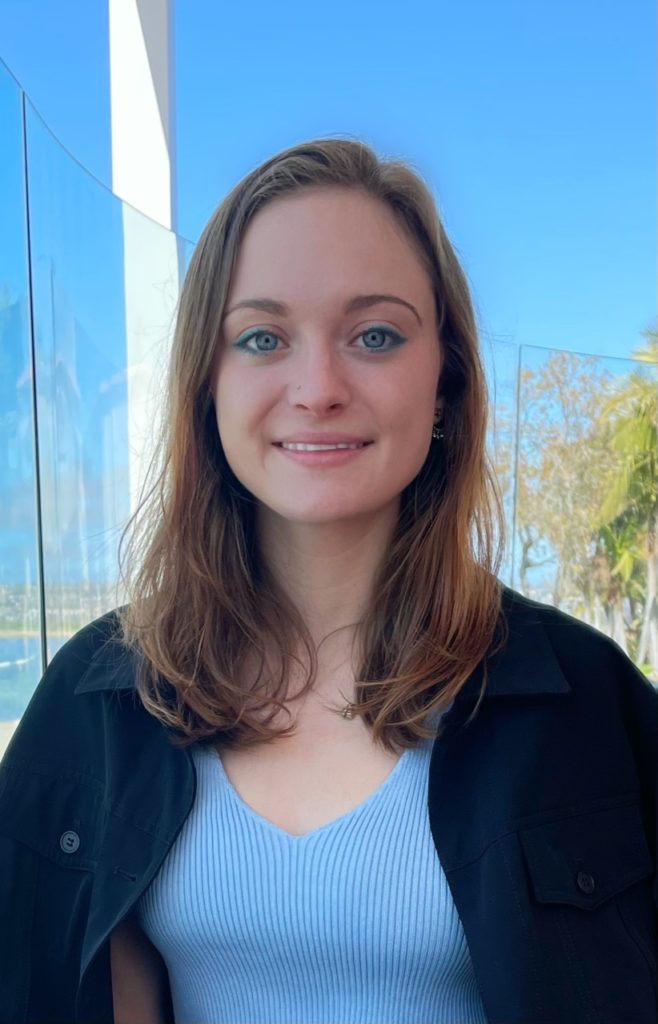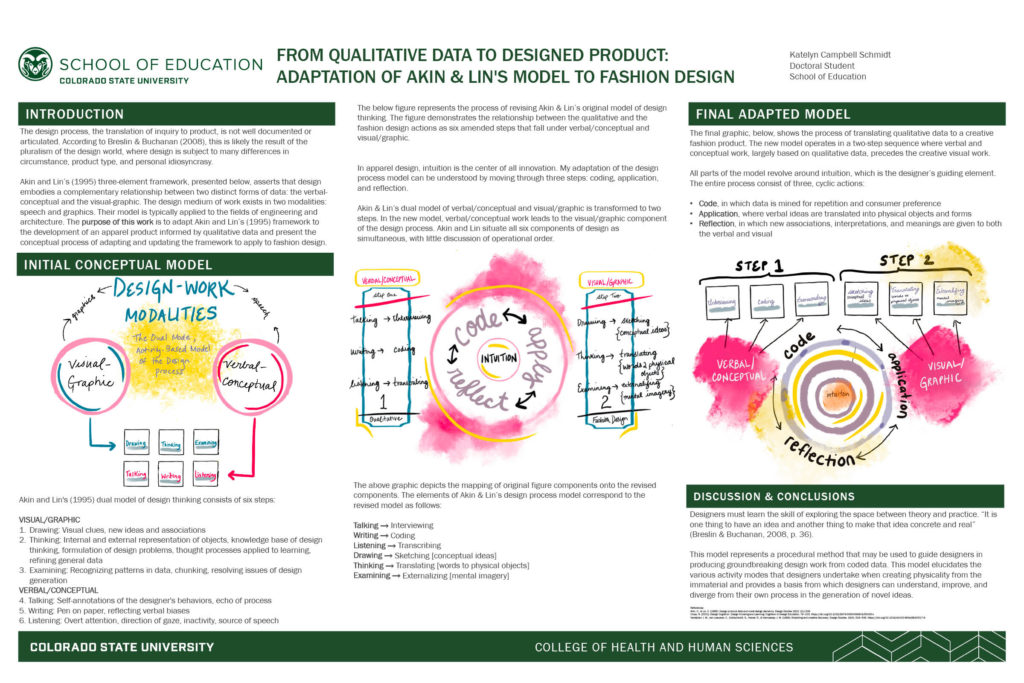 Colorado State University student Katelyn Schmidt’s academic journey shows how the diverse units within the College of Health and Human Sciences intersect in unexpected ways.
Colorado State University student Katelyn Schmidt’s academic journey shows how the diverse units within the College of Health and Human Sciences intersect in unexpected ways.
An alumna of the Department of Design and Merchandising, one of the eight academic units housed in the College, Schmidt (M.S., ’20) knew she wanted to teach apparel design when she first applied to the program.
“I came to CSU in 2018, right after I graduated from undergrad. I’d wanted to teach apparel design since my sophomore year at Kent State,” said Schmidt. “I really felt passionate about the creativity that goes into design, and it was always really exciting to see everyone’s ideas and participate in class critiques.”
In addition to her experience as an undergraduate student in Ohio, Schmidt attributes her interest in teaching to the influence of Jen Ogle, professor in the Department of Design and Merchandising. Throughout her time in the master’s program, Schmidt served as Ogle’s graduate teaching assistant.
“Kate is a true gem of a student,” said Ogle. “The joy she takes in learning and discovery is palpable, and she is always striving to do her best possible work. The research enterprise has captured her imagination – to the research task, she brings a wonderful combination of intellect, creativity, enthusiasm, and grit that propel her forward in a rather special way. She also is one of the most gracious, sincere, humble, ethical, hard-working, and dedicated students whom I have encountered in my 22 years of college teaching.”
Finding her way
During her time in the master’s program, Schmidt chose to take a qualitative research course offered by the School of Education, also housed in the College. Taught by Assistant Professor Jill Zarestky, the course was a pivotal point in Schmidt’s journey.
“In Dr. Zarestky’s qualitative course, I created a project based off consumer data I collected and developed a series of illustrations,” said Schmidt. “Dr. Zarestky said she’d never seen anything like this before. I expressed to her that I was really interested in being a professor, and she suggested I consider a Ph.D. in education.”
The Education, Equity and Transformation program is one of several Ph.D. options offered by the School of Education. The EET program is designed to set a strong foundation in research and teaching, with an interdisciplinary component that allows students to tailor their program of study to fit their goals and interests. This approach makes the degree a great option for students like Schmidt, who want to use their industry knowledge and expertise to teach others.
“My assistantship with Design and Merchandising solidified to me that I really wanted to pursue teaching,” said Schmidt. “I felt fulfilled in my background in design and what I’ve learned in apparel design. I was ready to learn about education and how I can teach adult learners, so I thought it would better serve me to study something that will help me become a professor.”
When Schmidt shared with Zarestky that she’d decided to apply to the EET program, Zarestky offered to serve as Schmidt’s doctoral adviser.
“Kate impressed me in class, so I was excited when she approached me about continuing her studies through the EET doctoral program,” said Zarestky. “I had expected a design student to be artistic and creative, but her analytic skills and beautiful writing style really elevated her work.”
“I was just completely thrilled by that,” said Schmidt, “because I think she’s really an amazing teacher and she’s proven to be even more amazing as an adviser. I really like her perspective, and her willingness to constantly learn and to help me move forward in design even though that’s not her background.”
Schmidt also discussed her intent to apply to the EET program with Ogle, seeking her advice as a mentor in the design field.
“Kate shared with me that she plans to pursue a career in academia after completing her doctoral studies, and I am so excited to watch her career unfold,” said Ogle. “Certainly, her intellectual curiosity, passion for her work, and admirable personal attributes will serve her well as she pursues this goal.”
Thesis becomes art
As a master’s student, Schmidt took what she learned from Zarestky’s qualitative course and applied it to her master’s thesis, “Girl Powder.” A skier herself, Schmidt felt frustrated with the skiing apparel available to women and decided to design and construct her own line of skiwear for women.
“Through my research, I found that, although women drive most of consumer spending in nearly every other sector, they’ve reported dissatisfaction with garments in the outdoor industry and spend less on outdoor apparel than men,” said Schmidt. “Outdoor industries aren’t designing for women; rather, they tend to design for men first, then ‘shrink and pink’ the garments for women. It was my goal to create a collection of women’s outdoor apparel that was actually designed for women.”
While conceptualizing “Girl Powder,” Schmidt collected consumer data through observation sessions at REI and interviews with women who were seeking outdoor apparel. Then, she applied the Functional, Expressive, and Aesthetic Consumer Needs Model to identify problems that needed to be addressed in the garments and sketched her ideas. Kevin Kissell, an assistant professor for the Department of Design and Merchandising, had this to say about Schmidt’s work: “I had the pleasure of serving on Kate’s graduate committee, and from the moment I read her thesis and saw her design work I knew that she had amazing talent and potential for both the fashion industry and in academia.”
An industry critique helped her pare down the ideas into seven looks composed of 19 individual pieces – all of which Schmidt turned into physical garments. These garments are slated to appear in the Avenir Museum of Design and Merchandising, located at the University Center for the Arts, in Spring 2022.
Navigating a learning curve
Schmidt has nearly completed her first year of the Ph.D. program. The transition from design to education has included, as she notes, a learning curve that involves adding new jargon and intricacies to her understanding. Added to this challenge is beginning doctoral studies during a pandemic, which has temporarily moved in-person EET courses online. Schmidt takes all this in stride, however, noting that working with faculty who leverage distance learning modalities well makes all the difference.
“Dr. Zarestky really makes an effort to make everyone in her advising group feel very welcome and included and supported,” said Schmidt, “and I’m really grateful for that – especially in this time.”
Changing disciplines for a graduate degree may be daunting, but Zarestky sees the connections, making the learning curve slightly easier for Schmidt to navigate.
“Like apparel design, so much of education is about innovation and problem-solving – Kate’s background translates well,” said Zarestky.
Zarestky’s practice is to gather her research group biweekly, via online meetings, to share experiences, discuss challenges and collaborations, and build rapport.
“It’s really been helpful to have that group – who are in different stages of the program – and to hear their experiences and understand what they’re going through,” said Schmidt. “I’ve been able to build a lot of really cool friendships through that. Not only friendships; we’re planning on doing research together. Dr. Zarestky is at the forefront, encouraging us to make these connections and to have this place where we can be friends and work together efficiently, which I think is really unique.”
Application of learning
Schmidt is already putting to work the knowledge she’s gaining about teaching as a graduate teaching assistant in the Department of Design and Merchandising. This semester, she’s working with Kissell, assisting with his AM110 Apparel and Merchandising Digital Technology course.
“I definitely think the courses I’m taking now are affecting how I’m approaching different topics with students,” said Schmidt. “Especially as I get deeper into the literature, I think my understanding of teaching is really going to evolve. I’m learning that, in design, pedagogy is important. Students have a broader contextual view of what’s going on with design thinking and conceptualization, so if you can take the focus off that final tangible product and make sure they understand the broader goal in design thinking first, then the final products are going to be improved.”
As a teacher, Schmidt has demonstrated her passion for design, creating quite the reputation for her craft within Design and Merchandising.
“I was lucky to have her as a graduate teaching assistant for AM 244 – Fashion Illustration, and when Kate walks into the room, people pay attention,” said Kissell. “Our students were in awe when she started her first fashion sketching demonstration.”
In addition to teaching, Schmidt is interested in studying the intersection of apparel design and similarly creative disciplines with pedagogy, the art and sciences of teaching, education, and instructional design. Currently, she’s working to determine whether frameworks already in place for other creative fields, such as architecture, could be adapted for apparel design to better understand the design thinking process. This effort led to Schmidt’s poster presentation during the 2021 CHHS Research Day Virtual Poster Show.

“My hope was that this model could provide a basis for designers and design students to understand their own thinking process, hopefully improve it, and then eventually diverge from that process in order to create their ideas,” said Schmidt. “I think, if you can understand what’s happening, then you can improve it. I don’t think many researchers have taken a deep dive into understanding what’s behind the design process in apparel design.”
Deep roots

Schmidt’s experience as a student in the Design and Merchandising master’s program helped her to develop strong connections throughout the department.
“As a TA for Dr. Ogle, I realized that she is the kind of teacher I want to be – I’d like to emulate her teaching style, because she is so knowledgeable but presents that knowledge in an easygoing way,” said Schmidt. “Kevin [Kissell] has been really pivotal in my development and wanting to pursue teaching. He’s also an amazing instructor and has a way of interacting with students so they feel comfortable and respect him.”
Schmidt’s diverse group of mentors shares confidence in her ability to achieve her goals while adding to the fields of design and education.
“Kate is so genuine, dedicated, and humble,” said Kissell. “I am so excited to see what the future holds for her. Whatever she chooses to do, she will be a force!”
Deeply rooted in Design and Merchandising, Schmidt knows that her ability to grow as a teacher and researcher is helped by those who support her in tangible and intangible ways.
“It’s been the people that I’ve been surrounded by – their support and seeing them in action – that has really help me on this path,” said Schmidt. “I think it’s about how you treat people. I’ve learned that from people in my master’s program and the beginning of my Ph.D. I feel really grateful for that.”
The School of Education, Department of Design and Merchandising, and Avenir Museum of Design and Merchandising are part of CSU’s College of Health and Human Sciences.